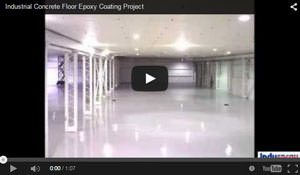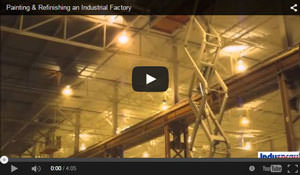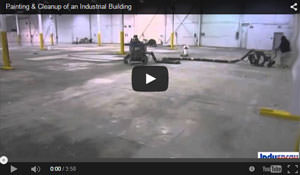Pride of Appearance and cleanliness count for a lot.
Dust. It coats parts and makes them look like they have been hanging around for months. It gets into automated equipment and forklift trucks to cause them to malfunction or come to a premature end. It gets into motors in mechanical rooms forcing bearings to seize. Inhaled by your lungs, it makes you sick. In short, it is at best a nuisance and at worse a hazard.
Believe it or not, most of the dust in plants and warehouses is created by the unsealed concrete floors. Unsealed floors start dusting from day one. Water evaporating from the concrete mix leaves minute pockets or pores. Then, small particles wear off as the pores get crushed under traffic loads. We are not just talking about cheaply laid floors. Even the most expensive concrete floor begins to deteriorate from the moment it is laid. Concrete is always curing, so there is always dust being created.
As the floor wears, rough spots and potholes form, to take their toll on mobile equipment. Higher wheel replacement cost and equipment downtime become inevitable. But this doesn’t have to happen to you.
Concrete floors can have their deterioration stopped and the damage reversed.
Advances in epoxy technology have developed coatings that can protect a concrete floor and extend its life, while eliminating the dusting it had previously been producing. These epoxies all called 100% solids because they do not have any solvents in them, and 100% of all the material stays on the floor rather than evaporating into the atmosphere. The added benefit to using 100% solid coatings is that because they contain no solvent, they have no hazardous odor and can be installed during regular production hours.
When embarking on any coating project, the most important step is preparation. The most expensive coating will be worthless if the surface it is applied to is not suitable.
There are 3 main methods utilized to prepare concrete floors:
Mechanical Shot-Blasting – A large machine blasts the floor with steel shot the size of large grains of sand while simultaneously vacuuming up the dust and re-circulating the metal shot. This is the preferred method of professional floor installers, as it both cleans and profiles the floor for optimal chemical and mechanical adhesion.
Acid Washing – The floor is etched with muriatic or hydrochloric acid and neutralized. This method works well on a clean, previously uncoated floor but is not useful when the floor has oil or has a previous coat of paint or sealer.
Diamond Grinding, Sanding, or Scarifying – The floor is sanded or scarified with large orbital machines sometimes using diamond grinding bits. This opens up the pores of the floor, but does not profile it. Useful around columns or edges of walls where the shot-blast machine will not access.
Once the floor is shot-blasted, all the holes and cracks are filled with a trowelable epoxy. The floor is then coated with 20 mils of clear or coloured 100% solids epoxy. Normally the expansion joints are left as- is, unless the facility is to be used for pharmaceutical or food preparation use. If this is the case, following coating, the expansion joints can have a backer rod installed and flexible joint caulking installed that will move with the slab.
Maintenance of coated floors is of course made easier — the standard dust mop treatment or perhaps weekly power scrubbing with the plant’s ride- on machine. What once took 2 or 3 pushes of a broom now takes one push with a dust mop. Many facilities have found their cost for cleaning over a 5 year period has been cut in half, including the cost of applying the epoxy coating.
Floor coating can also reduce energy costs. A light coloured floor can be utilized to increase the illumination from current lights, or enable lower wattage lighting to be installed while maintaining the current lighting levels.
As companies are now being held accountable for the environmental cleanup of their sites, those involved in risk management see the benefit that coated floors can offer them. The impermeable nature of epoxy coatings allows spilled liquids to be cleaned up rather than penetrating the floor and entering the ground over time. In facilities where spills are common, this can amount to hundreds of thousands of dollars in savings.
Other benefits that are more difficult to quantify are aesthetics and pride of ownership. If you create a nice working atmosphere, your staff want to keep it clean. As perception is important these days, many customers judge a company on how clean and new looking its facilities are. In today’s competitive environment, everything is in the details. 10 years ago, buyers and manufacturers were sitting down in the boardroom to conduct their deals, today they are out on the production floor. Buyers want to see production and warehouse areas and how well they are maintained, and businesses are seeing an increase in their orders due to well maintained and bright facilities.
When looking into having your floors sealed, choosing the right contractor is the most important part. There has been an explosion in contractors offering floor coating installation over the past 10 years. As the industry is not regulated, it is up to the consumer to ensure they educate themselves so they can make the best decision as to what coating they want to use, and who they want to do it. Just as with all contracting jobs, it is important to check references and it would be a good idea to visit an old job to see how it is holding up.
Make sure the coatings being used are produced by a large manufacturer that will stand behind its products if there was a failure. Some smaller contractors attempt to save money by making their own epoxies.
Floor projects are priced per square foot and dependant up on the thickness of material applied. 100% solids epoxies should normally be 18 to 20 mils (thousandths of an inch) thick. This is usually more than adequate to fill in the blast lines left by preparation. If you see excessive blast lines in the floor, the contractor may not have put sufficient material down, and you are paying for material you never received.
Make sure you get proof of insurance and workers compensation coverage prior to any work starting.
Induspray is a professional epoxy floor coating contractor servicing manufacturing and warehouse facilities. Have questions about painting, sealing, or epoxy coating your concrete floor? Contact us today — we’re here to help.
* Induspray article, published in Property Management Magazine, 2006
[-] TO CLOSE THIS TEXT, CLICK ON HEADING ABOVE
























